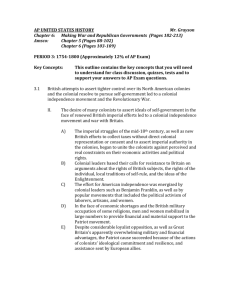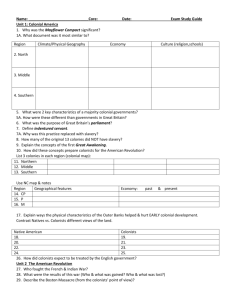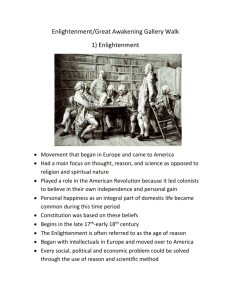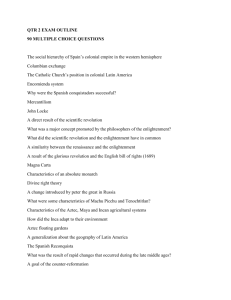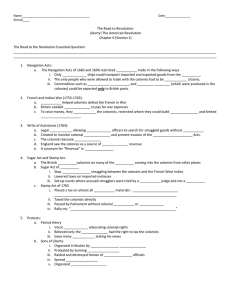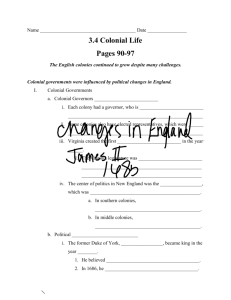Document 11949068
advertisement
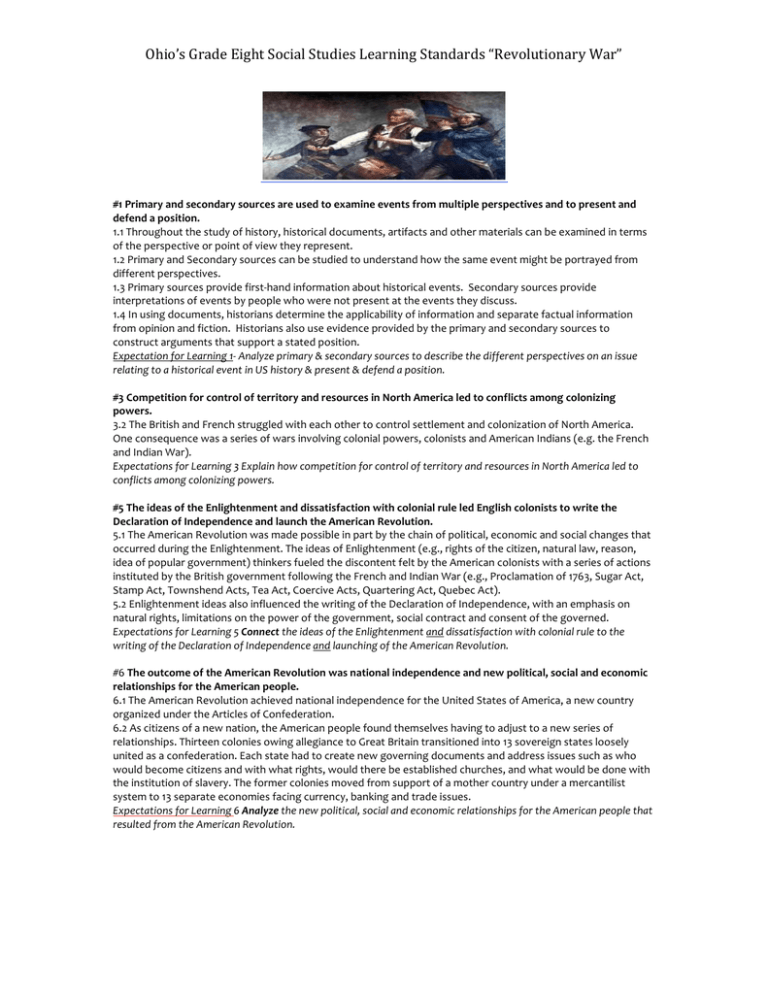
Ohio’s Grade Eight Social Studies Learning Standards “Revolutionary War” #1 Primary and secondary sources are used to examine events from multiple perspectives and to present and defend a position. 1.1 Throughout the study of history, historical documents, artifacts and other materials can be examined in terms of the perspective or point of view they represent. 1.2 Primary and Secondary sources can be studied to understand how the same event might be portrayed from different perspectives. 1.3 Primary sources provide first-­‐hand information about historical events. Secondary sources provide interpretations of events by people who were not present at the events they discuss. 1.4 In using documents, historians determine the applicability of information and separate factual information from opinion and fiction. Historians also use evidence provided by the primary and secondary sources to construct arguments that support a stated position. Expectation for Learning 1-­‐ Analyze primary & secondary sources to describe the different perspectives on an issue relating to a historical event in US history & present & defend a position. #3 Competition for control of territory and resources in North America led to conflicts among colonizing powers. 3.2 The British and French struggled with each other to control settlement and colonization of North America. One consequence was a series of wars involving colonial powers, colonists and American Indians (e.g. the French and Indian War). Expectations for Learning 3 Explain how competition for control of territory and resources in North America led to conflicts among colonizing powers. #5 The ideas of the Enlightenment and dissatisfaction with colonial rule led English colonists to write the Declaration of Independence and launch the American Revolution. 5.1 The American Revolution was made possible in part by the chain of political, economic and social changes that occurred during the Enlightenment. The ideas of Enlightenment (e.g., rights of the citizen, natural law, reason, idea of popular government) thinkers fueled the discontent felt by the American colonists with a series of actions instituted by the British government following the French and Indian War (e.g., Proclamation of 1763, Sugar Act, Stamp Act, Townshend Acts, Tea Act, Coercive Acts, Quartering Act, Quebec Act). 5.2 Enlightenment ideas also influenced the writing of the Declaration of Independence, with an emphasis on natural rights, limitations on the power of the government, social contract and consent of the governed. Expectations for Learning 5 Connect the ideas of the Enlightenment and dissatisfaction with colonial rule to the writing of the Declaration of Independence and launching of the American Revolution. #6 The outcome of the American Revolution was national independence and new political, social and economic relationships for the American people. 6.1 The American Revolution achieved national independence for the United States of America, a new country organized under the Articles of Confederation. 6.2 As citizens of a new nation, the American people found themselves having to adjust to a new series of relationships. Thirteen colonies owing allegiance to Great Britain transitioned into 13 sovereign states loosely united as a confederation. Each state had to create new governing documents and address issues such as who would become citizens and with what rights, would there be established churches, and what would be done with the institution of slavery. The former colonies moved from support of a mother country under a mercantilist system to 13 separate economies facing currency, banking and trade issues. Expectations for Learning 6 Analyze the new political, social and economic relationships for the American people that resulted from the American Revolution. Ohio’s Grade Eight Social Studies Learning Standards “Revolutionary War” #13 Modern and historical maps and other geographic tools are used to analyze how historic events are shaped by geography. 13.1 Modern and historical maps, as well as other geographic tools (eg. GPS. GIS. Internet-­‐based mapping applications, aerial and other photographs, remote sensing images) can be used to analyze how historical events have been influenced by the distribution of natural resources and geographic location. 13.2 These tools can be used to understand changes over time. They may be used to help illustrate sectionalism, unification or movement. Expectations for Learning 13 Analyze the ways in which historical events are shaped by geography using modern and historical maps and other geographical tools. #17 Americans began to develop a common national identity among its diverse regional and cultural populations based on democratic ideals. 17.1 The democratic ideals that became the cornerstone for the development of a common national identity were freedom, equality, rights and justice. Many of these ideals were reflected in the colonial governments, formed the basis for the colonists’ disagreements over British policies, and were embedded into the U.S. Constitution and Bill of Rights. Expectations for Learning 17 Identify the developments that helped bring about a common national identity for Americans and describe the democratic ideals around which that identity is based. #18 Participation in civic groups can lead to the attainment of individual and public goals. 18.1 Throughout early American history, there are examples of how participation in civic groups led to the attainment of individual and public goals. Civic groups included the Sons of Liberty, which worked to protest British colonial policy. Expectations for Learning 18 Explain how participation in civic groups can lead to the attainment of individual and public goals. #19 Informed citizens understand how media and communication technology influence public opinion. 19.1 Media and communication technology influence public opinion through a variety of means. Historically, this includes improvements in printing, mail delivery, distribution of newspapers and the telegraph, which heightened public awareness and provided information. They also exposed people to arguments, emotional appeals and propaganda. 19.2 Public opinion in early American history was influenced by pamphlets, books and newspaper articles (e.g., Common Sense). Expectations for Learning 19 Explain how media and communication technology influence public opinion. #22 Choices made by individuals, businesses and governments have both present and future consequences. 22.3 Governments must consider which public goods and services (e.g. military protection) they provide with available revenue (from taxes). They also must weigh the immediate and future impact of raising or lowering revenue through tax and tariff policy. 22.4 Historical decisions based in part on economic choices include: Imposing new taxes on the American colonies. Expectations for Learning 22 Analyze how choices made by individuals, businesses and governments have both present and future consequences.
